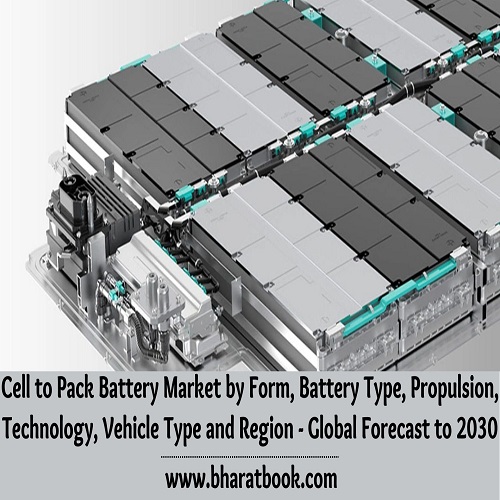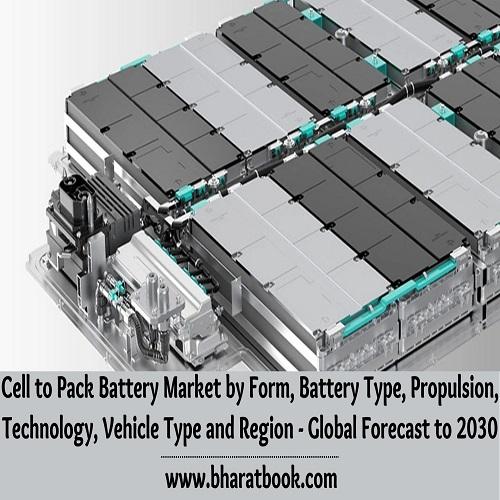Bharat Book Bureau Provides the Trending Market Research Report on “Cell to Pack Battery Market by Form (Prismatic, Pouch, Cylindrical), Battery Type (LFP, NMC), Propulsion (BEV, PHEV), Technology (Blade, LiSER), Vehicle Type (Passenger Cars, Commercial Vehicles) and Region - Global Forecast to 2030” under Automotive Market Research Report Category. The report offers a collection of superior Market research, Market analysis, competitive intelligence and Market reports.
The Cell To Pack Battery Market is projected to grow from USD 5.5 billion in 2023 to USD 29.3 billion by 2030 at a CAGR of 26.9%. The growth of this market is mainly driven by the increasing demand for high-voltage batteries to achieve a longer drive range. CTP battery is one of the results of such advancement, which eliminates the usage of modules and directly integrates cells into battery packs. This allows the use of larger and more cells within battery packs with reduced interconnections and a simplified assembly process resulting in an increased volumetric density of batteries and reduced cost. CTP technology is yet to be commercially launched in most EV-dominating countries. It is expected to gain traction by 2024−2025 in the US, South Korea, Japan, and European countries.

"Passenger electric vehicles is the largest market for cell to pack battery."
The demand for electric passenger cars has increased in the past few years owing to the rising demand for safer personal commutes in inter-city and cross-country travel. Asia Pacific is predicted to be the largest market for the sale of passenger electric cars, with China being the major contributor in the region. Demand for electric passenger cars in Europe and North America has also grown due to rising fuel prices and increasing awareness for decarbonized vehicles. Some electric passenger car models offer an average driving range of 500-600 km, but these are higher-ranged electric passenger cars. Cell to pack batteries would help to equip economical electric passenger cars with high energy density at lower cost and reduced weight.
Further, cell to pack battery technology will support the noteworthy developments undertaken by electric vehicle manufacturers in high-voltage battery areas for the passenger cars segment to improve vehicle range and reduce charging time. For instance, Hyundai and Kia have introduced high-speed 800V architecture for upcoming passenger vehicles. Porsche has an EV model Taycan which supports an 800 V battery architecture. Other OEMs have also announced using cell to pack batteries in upcoming models.
In December 2021, Toyota Motor Corporation partnered with BYD Company Ltd. to build an electric car with a blade battery. In October 2021, Hyundai MOBIS (South Korea) entered a partnership with CATL, wherein CATL would supply the cell- to-pack battery technology to Hyundai MOBIS. This will likely bring some EV models to South Korea from 2023−2024 onwards. Further, a few Chinese OEMs – BYD Company Ltd., Neta, Xpeng Inc., etc. have either expanded or planned to expand with electric passenger car models in other parts of the world. All of these factors will help to dominate the passenger vehicle segment for cell to pack battery market
"Lithium iron phosphate chemistry to hold the largest share in the cell to pack battery."
Lithium iron phosphate (LFP) battery chemistry (a form of Lithium-ion battery) is also the most preferred choice among other chemistry for cell to pack battery technology. LFP batteries offer numerous advantages such as lightweight, lower cost, enhanced discharge, charge efficiency, durability, longer life span, minimal maintenance, and optimized safety, among others. Owing to these benefits, >90% of batteries developed with the cell to pack technology use LFP chemistry across all-electric vehicles.
In October 2021, Tesla declared that it would completely switch to LFP batteries in all its models owing to lower cost and easy production process rather than using NCA batteries for increasing the range of its vehicles. Currently, Tesla has adopted the use of LFP batteries in its best-selling models like Model 3 and Model Y. Apart from passenger cars, LFP has also been used in electric buses due to its lower costs and high voltage bearing feature. Thus, these factors and the need for an optimized energy density range would drive the LFP batteries' demand for CTP technology over the coming years.
Europe is speculated to be the fastest-growing market for cell to pack battery
Europe is anticipated to grow at the fastest rate for cell to pack battery market by 2030. Europe is witnessing significant expansion in the micro-cars segment owing to factors such as the stringent carbon emission mandate, incentive boost by green recovery funds, viable charging infrastructure, and intense promotion of electric and plug-in hybrid vehicles. The market demand for cell to pack batteries will be initially driven by the entry of foreign OEMs with vehicles equipped with this technology. For instance, BYD Tang, Han EV, and Atto 3 are offered in some European countries, including Norway, Germany, Sweden, and the UK.
Tesla sells Model 3 and Model Y in Europe and is expected to deploy cell to pack batteries in these models in the coming years as it has started deploying these CTP batteries in China. Further, some electric commercial vehicle manufacturers (Solaris Bus & Coach sp. z o.o., VDL Bus & Coach BV) have partnered with Chinese battery supplier- CATL to receive cell to pack batteries in electric buses. However, the Russia-Ukraine crisis has disrupted the supply chain for batteries and other raw material supplies for electric vehicles and also affected EV sales to some extent. The situation is anticipated to recover in the coming years, thereby fueling the demand for cell to pack batteries in the years to come.
In-depth interviews were conducted with CEOs, marketing directors, other innovation and strategy directors, and executives from various key organizations operating in this market.
- By Stakeholders: Demand Side – 20% and Supply Side – 80%
•By Designation: C Level Executives - 10%, Directors - 30%, and Others – 60%
•By Region: Europe – 10%, North America – 10%, and Others – 80%
Contemporary Amperex Technology Co., Limited. (China), BYD Company Ltd. (China), LG Energy Solution. (South Korea), Tesla (US), XPENG INC. (China), C4V (US), and Sunwoda Electronic Co., Ltd. (China) are the leading supplier of cell to pack battery in the global market.
Research Coverage:
The cell to pack battery market is segmented By Form (Prismatic, Pouch, Cylindrical), Battery Type [Lithium Iron Phosphate (LFP), Nickel Manganese Cobalt (NMC), Other Battery Types], Propulsion (BEV, PHEV), Technology (Blade Battery Technology, LiSER Battery Technology, Other Battery Technology), Electric Vehicle Type [Electric Passenger Cars, Electric Commercial Vehicles (Buses and Trucks)], and Region (Asia Pacific, Europe, and North America).
The study also includes an in-depth competitive analysis of the major cell to pack battery manufacturers in the market, their company profiles, key observations related to product and business offerings, recent developments, and key market strategies.
Key Benefits of Buying the Report:
The report will help the market leaders with information on the closest approximations of the revenue numbers for the overall cell to pack battery market and the sub-segments. This report covers technological trends like improved battery designs and battery chemistry, the development of new cell to chassis battery technology about cell to pack battery market, which would help the stakeholders to understand more about the battery technology advancements in the industry. This report would help stakeholders understand the fastest growing market that is Europe, and the largest market that is Asia Pacific, for cell to pack batteries at regional and global levels and the factors influencing the growth of these regions. This report will help stakeholders to understand the competitive landscape and gain more insights to position their businesses better and plan suitable go-to-market strategies. The report also helps stakeholders understand the market's pulse and provides information on key market drivers, restraints, challenges, and opportunities.
Browse our full report with Table of Content :
https://www.bharatbook.com/report/1400095/cell-to-pack-battery-market-by-form-prismatic-pouch-cylindrical-battery-type-lfp-nmc-propulsion-bev-phev-technology-blade-liser-vehicle-type-passenger-cars-commercial-vehicles-and-region-global-forecast-to
About Bharat Book Bureau:
Bharat Book is Your One-Stop-Shop with an exhaustive coverage of 4,00,000 reports and insights that includes latest Market Study, Market Trends & Analysis, Forecasts Customized Intelligence, Newsletters and Online Databases. Overall a comprehensive coverage of major industries with a further segmentation of 100+ sub sectors.
Contact us at:
Bharat Book Bureau
Tel: +91 22 27810772 / 27810773
Email: [email protected]
Website: www.bharatbook.com
